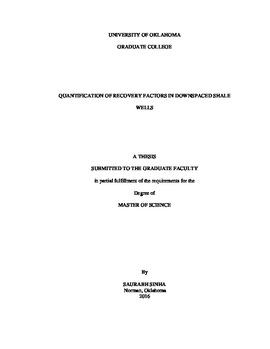| dc.contributor.advisor | Devegowda, Deepak | |
| dc.contributor.author | Sinha, Saurabh | |
| dc.date.accessioned | 2016-12-20T21:22:27Z | |
| dc.date.available | 2016-12-20T21:22:27Z | |
| dc.date.issued | 2016-12-16 | |
| dc.identifier.uri | https://hdl.handle.net/11244/47108 | |
| dc.description.abstract | Well spacing optimization in horizontal multi-fractured wells is the center of field development. Unconventional reservoirs due to the low matrix permeability cannot produce without the help of hydraulic fracturing. Unlike the conventional reservoir where all wells draw production from a connected reservoir, an unconventional reservoir acts as an isolated reservoir for each well bounded by the transverse fracture tips.
As there is no contribution beyond the fracture tips, the best way to produce from an unconventional reservoir to place the wells close enough that no portion of the reservoir remains undrained. This optimal well spacing can be quantified in terms of recovery factor for each well. Hence to exploit the field optimally, the recovery factors needs to be maximized. But, beyond a certain well spacing placing wells further close to each other may lead to well interference and a reduction in recovery factors. This thesis seeks to find a robust well spacing workflow for unconventional reservoirs by integrating data from multiple data sources. The study area in this thesis is the rich condensate portion of Eagle Ford shale. Eagle Ford shale in this area provides maximum value for the operators due to high condensate recovery factors.
The total Eagle Ford thickness in the area of interest varies from 200-250 ft. The different sequences can be identified on the well logs in this area as: upper, middle and lower Eagle Ford. Rock typing in this area suggests 4 different rock types that could be production drivers in Eagle Ford. A 3-D lithological model is generated from well logs shows that the upper and middle Eagle Ford consists of small scale heterogeneities distributed all across the reservoir. Lower Eagle Ford however, is a more uniform and continuous interval. From 3D model, lithology constrained porosity and water saturation show that the lower Eagle Ford comprises of high porosity and low water saturation.
Microseismic data from a PAD well is used to generate fracture networks and hence the stimulated reservoir rock volume (SRV). Microseismic data shows the growth of the fracture network and drainage areas are irregular and full 500 ft. spacing between the wells is not drained. The same is also verified after matching the historical production data.
Well spacing sensitivities on the history matched model show that 420 ft. well spacing is optimal in this area. To verify the simulation results a multivariate statistical analysis is performed on Arp’s decline parameters i.e. initial production, decline and b factor on more than 1500 wells. The regression model suggests the optimal well spacing to be 400 ft. The statistical analysis hence verified the simulation results and further bolstered the conclusion that 400-420 ft. well spacing is optimal in rich condensate area of Eagle Ford shale. | en_US |
| dc.language | en | en_US |
| dc.subject | Downspaced, Reservoir Simulation, Shale gas, completion optimization, choke management | en_US |
| dc.title | Quantification of recovery factors in downspaced shale wells | en_US |
| dc.contributor.committeeMember | Pranter, Matthew J. | |
| dc.contributor.committeeMember | Fahes, Mashhad | |
| dc.date.manuscript | 2016-10-26 | |
| dc.thesis.degree | Master of Science | en_US |
| ou.group | Mewbourne College of Earth and Energy::Mewbourne School of Petroleum and Geological Engineering | en_US |
| shareok.nativefileaccess | restricted | en_US |
